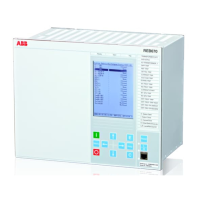en04000146_ansi.vsd
Open
Closed
Operate time
Line
protection
Circuit
breaker
Break time
T
rip com
m
and
C
ontacts separated
A
re extinguishers
Fault duration AR open time for breaker
Fault duration
R
esets
Instant of fault
O
perates
Break timeClosing time
Operate
time
F
ault
O
perates
R
esets
C
lose com
m
and
C
ontact closed
Set AR open time
Auto-reclosing
function
R
eclosing
com
m
and
A
R
re
s
e
t
In
itia
te
A
R
Reset time
ANSI04000146 V1 EN-US
Figure 124: Single-shot automatic reclosing at a permanent fault
Single-pole tripping and single-phase automatic reclosing is a way of limiting the
effect of a single-phase line fault on power system operation. Especially at higher
voltage levels, the majority of faults are of single-phase type (around 90%). To
maintain system stability in power systems with limited meshing or parallel routing
single-phase auto reclosing is of particular value. During the single-phase dead time
the system is still capable of transmitting load on the two healthy phases and the
system is still synchronized. It requires that each circuit breaker pole can be operated
individually, which is usually the case for higher transmission voltages.
A somewhat longer dead time may be required for single-phase reclosing compared to
high-speed three-phase reclosing. This is due to the influence on the fault arc from the
voltage and the current in the non-faulted phases.
To maximize the availability of the power system it is possible to choose single-phase
tripping and automatic reclosing during single-phase faults and three-phase tripping
and automatic reclosing during multi-phase faults. Three-phase automatic reclosing can
be performed with or without the use of synchrocheck.
1MRK 505 370-UUS A Section 12
Control
Busbar protection REB670 2.2 ANSI 315
Application manual

